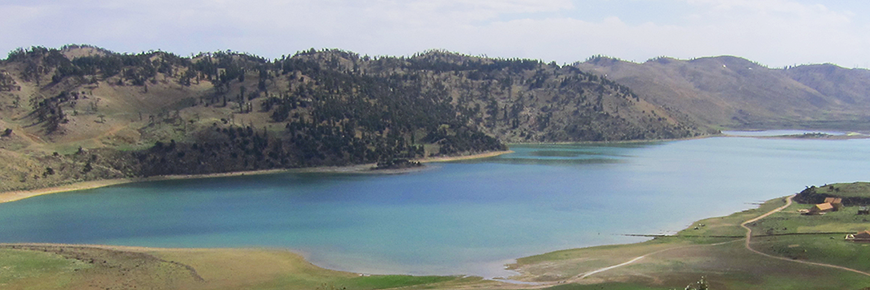21.07.2017: The Sahara is the largest dry desert of the world and therewith the globally most intense producer of dust. This dust fertilizes the oceans and has an impact on climate evolution and terrestrial ecosystems. An international team of scientists led by the University of Leipzig and with the participation of the GFZ now reconstructed the evolutionary history of the Sahara based on dust sediments from a Moroccan lake.
The Sidi Ali Lake in the Mid Atlas in Morocco is located on 2,080 metres above sea level, immediately adjacent to the northern edge of the Sahara. Based on dust sediments found in this lake the scientists traced back the occurrence of dust storms back to 12,000 years before present. Their results were now published in the scientific journal Quaternary Science Reviews.
The area of today’s Sahara has not always been a desert. There were times when life has flourished and spacious savannas and steppes were habitats for lions, elephants, and humans. Previous studies assumed an end of this “green Sahara” between 7,000 and 3,000 years before present. How the Sahara became today’s desert is still discussed.
Based on the grain size distribution of the analyzed lake sediments, Elisabeth Dietze, GFZ section Climate Dynamics and Landscape Evolution, showed that the sediments were indeed transported into the lake by Saharan dust storms. “As the fine mineral particles did not come from the lake catchment or local sources, we assume that fine silt-sized dust originated from across the Sahara, was trapped along the Atlas mountains during high atmospheric level transport and finally archived within the lake“. Hence, the occurrence of fine dust in the lake sediments may indicate that the Sahara became drier, since a sparse vegetation cover allows dust production and translocation.
The team contributes to a larger debate on how the “green Sahara” became dry showing that not only a gradual drying or an abrupt transition took place. In fact, several phases of dust sedimentation in the lake point at a rather stepwise transition from humid to arid conditions. Short-term phases of Saharan dust deposition and “trans-Saharan” aridification took place since the maximum of the African humid period and accompanied the drying trend until the dry modern Sahara was established around 4,700 years before present. (ak)
Original study: Zielhofer, C., von Suchodoletz, H., Fletcher, W.J., Schneider, B., Dietze, E., Schlegel, M., Schepanski, K., Weninger, B., Mischke, S., Mikdad, A., 2017. Millennial-scale fluctuations in Saharan dust supply across the decline of the African Humid Period. Quaternary Science Reviews 171, 119-135. DOI: 10.1016/j.quascirev.2017.07.010








![[Translate to English:] Torsten Sachs in front of a climate station on a field](/fileadmin/_processed_/3/9/csm__TorstenSachs_bearbeitet_GS_4a1365ef84.jpeg)

![[Translate to English:] left image flood at the Ahrtal: image from above, several houses are flooded; left image:: Heidi Kreibich;](/fileadmin/_processed_/4/4/csm_Bild2_9af0130e9f.png)



![[Translate to English:] Start der Vega Rakete](/fileadmin/_processed_/6/4/csm_20231201-kachel_Vega-VV23-launch_ESA-CNES-Arianespace_706716b68c.jpeg)









![[Translate to English:] Poster exhibition at the Brandenburg Hydrogen Day at the GFZ, some participants in the foreground](/fileadmin/_processed_/6/5/csm_Erster_Brandenburgischer_Wasserstofftag_GFZ_402fcec95e.jpeg)
![[Translate to English:] Group picture of the participants](/fileadmin/_processed_/9/4/csm_20231108_CAWa-Workshop-Tashkent_Gruppenbild_99ea779d8a.jpeg)

![[Translate to English:] [Translate to English:] Hörsaal](/fileadmin/_processed_/e/6/csm_H%C3%B6rsal_e21ac645fb.jpeg)


![[Translate to English:] The Delegations in the Historic Library on the Telegrafenberg. In the back there are from left to right, the Dutch Ambassador for Germany, Ronald van Roeden, the Dutch Minister for Education, Culture and Science, Robbert Dijkgraaf and the scientific director of the GFZ, Susanne Buiter.](/fileadmin/_processed_/d/b/csm_Kachel-2_9eba4b4212.jpeg)

